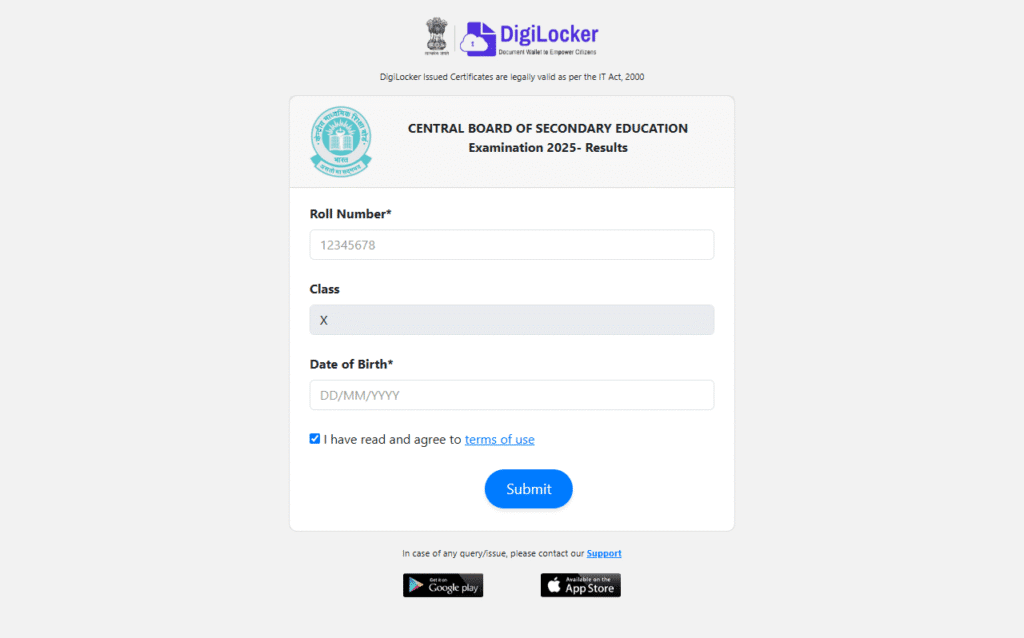
The Central Board of Secondary Education (CBSE) has officially announced the CBSE Class 10th Result 2025 . The results were declared on May 13, 2025 , and are now available online on the official websites: cbse.gov.in and cbseresults.nic.in .
Students who appeared for the exams can check their results using their roll number, date of birth, school number, and a security pin provided by the board.
Table of Contents
Important Details About CBSE Class 10th Result 2025
| Details | Information |
|---|---|
| Board | Central Board of Secondary Education (CBSE) |
| Exam Name | CBSE Class 10 Board Exam |
| Exam Dates | February 15 to March 18, 2025 |
| Mode of Exam | Offline (Pen & Paper) |
| Result Date | May 13, 2025 |
| Mode of Result | Online |
| Official Website | cbse.gov.in,cbseresults.nic.in |
Overall Performance of Students
- Total Registered Candidates : 23,85,079
- Candidates Who Appeared : 23,71,939
- Candidates Who Passed : 22,21,636
- Overall Pass Percentage : 93.66%
- Increase from Last Year : 0.06% (93.60% in 2024)
Gender-Wise Pass Percentage
- Girls : 95.00%
- Boys : 92.63%
- Transgender : 95.00%
Girls outperformed boys with a difference of 2.37% . Transgender students also showed strong performance, matching the girls’ pass percentage.

Region-Wise Performance
Some regions stood out for their high pass percentages:
| Region | Pass Percentage |
|---|---|
| Trivandrum | 99.79% |
| Vijayawada | 99.79% |
| Bengaluru | 98.90% |
| Chennai | 98.71% |
| Pune | 96.54% |
| Delhi (West) | 95.24% |
| Delhi (East) | 95.07% |
| Prayagraj | 91.01% |
| Noida | 89.41% |
| Guwahati | 84.14%(lowest) |
Trivandrum and Vijayawada shared the top spot with 99.79% pass rates, while Guwahati recorded the lowest at 84.14% .
Performance Based on School Type
Different types of schools also showed varied results:
| School Type | Pass Percentage |
|---|---|
| Jawahar Navodaya Vidyalayas (JNVs) | 99.49% |
| Kendriya Vidyalayas (KVs) | 99.45% |
| Independent (Private Schools) | 94.17% |
| Government Schools | 89.26% |
| Government-Aided Schools | 83.94% |
Navodaya and Kendriya Vidyalayas continued to lead in academic excellence.
Delhi’s Performance
In Delhi:
- Registered Students : 3,28,701
- Appeared Students : 3,27,041
- Passed Students : 3,11,138
- Pass Percentage : 95.14%
Delhi students performed well above the national average.
Top Scorers
- Number of students scoring 90% or more : 1,99,944
- Percentage of students scoring above 90% : 8.43%
This shows that a significant number of students have excelled in academics this year.
How to Check CBSE Class 10th Result 2025
To check your result, follow these simple steps:
- Visit the official website: cbse.gov.in or cbseresults.nic.in
- Click on the link for “CBSE Class 10 Result 2025”.
- Enter your roll number, school number, admit card details, and security pin.
- Click on ‘Submit’ and view your result.
- Download and take a printout for future reference.
For complete details on Punjabi grammar rules, please click here
The CBSE Class 10 Result 2025 reflects steady improvement in student performance across the country. While some regions and school types continue to dominate the charts, there is room for growth in others like Guwahati and aided institutions.
We congratulate all the students, parents, and teachers for their hard work and dedication!
For more updates and exam-related information, keep visiting our rankerschoice.com website.
For aspirants preparing for competitive exams like Punjab PCS , UPSC , and other state-level exams in Punjab , staying updated with current affairs and educational trends is crucial. The latest CBSE Class 10th Result 2025 highlights various performance metrics across regions, school types, and gender, offering valuable insights into the state of education in India — a key topic often seen in general studies papers. Understanding data such as pass percentages, regional disparities, and institutional performance can help candidates answer questions related to education policy, socio-economic development, and governance more effectively.
Websites like RankersChoice.com provide well-researched articles, exam strategies, and study materials tailored for both central and Punjab-level exams . Aspirants can use these resources to build a strong foundation in subjects like polity, geography, economy, and current affairs . Regular reading and practicing mock tests available online can significantly boost confidence and accuracy. For long-term success, combining academic knowledge with consistent preparation through reliable sources is the key to cracking prestigious exams like UPSC and Punjab PCS .
Basic Information About Punjab – For Aspirants’ Knowledge
For students preparing for future exams or general awareness, here’s some basic information about Punjab , one of the most important states in North India:
| Aspect | Information |
|---|---|
| Capital | Chandigarh (shared with Haryana) |
| Largest City | Ludhiana |
| Official Languages | Punjabi |
| Population | Around 2.77 Crores (as per 2011 Census) |
| Area | 50,362 sq km |
| Famous For | Agriculture, especially wheat and rice production |
| Major Crops | Wheat, Rice, Sugarcane, Cotton |
| State Formation Day | November 1, 1966 |
| Literacy Rate | ~76% (lower than national average) |
| Popular Dances | Bhangra, Gidda |
| Popular Festivals | Lohri, Vaisakhi |
| Known As | “Land of Five Rivers” – Beas, Satluj, Ravi, Chenab, Jhelum |
Basic Information
- Formation Day : November 1, 1966 (as a Punjabi Suba after the reorganization of states)
- Population Rank in India : 20th
- Area Rank in India : 20th
- Sex Ratio : 895 females per 1000 males
Economy & Agriculture
- Known as the “Granary of India” or “Breadbasket of India”
- Green Revolution made Punjab a symbol of agricultural development in India
- Key industries: Textiles, dairy, food processing, and manufacturing
History & Culture
- Site of the Indus Valley Civilization (Mature Harappan phase)
- Associated with Sikhism – home to the Golden Temple (Harmandir Sahib), Amritsar
- Birthplace of Khalsa Panth (founded by Guru Gobind Singh in 1699 at Anandpur Sahib)
- Rich folk traditions: Bhangra, Gidda, Jhummar, and Sammi dances
- Popular festivals: Lohri, Baisakhi, Vaisakhi, Gurupurab
Geography
- Lies in the northwestern part of India
- Bordered by: Pakistan (southwest), Rajasthan (south), Haryana (southeast), Himachal Pradesh (northeast)
- Known as the “Land of Five Rivers” : Beas, Satluj, Ravi, Chenab, and Jhelum (all tributaries of Indus River)
- Alluvial soil supports high agricultural productivity
Governance & Administration
- Divided into 5 administrative divisions : Patiala, Ropar, Jalandhar, Faridkot, and Firozepur
- Total 23 districts
- Electorates: 13 Lok Sabha seats and 7 Rajya Sabha seats
- Famous for its military contribution – highest number of soldiers recruited from any state
To explore more about the rich history and culture of Punjab, please click here.
This basic understanding of Punjab’s historical, cultural, economic, and geographical significance helps build a strong foundation for competitive exams. Aspirants should also refer to current affairs, government schemes, and local developments in Punjab to stay updated for both state and national-level exams .
Punjab is known as the “food basket of India” due to its rich agricultural output. It plays a vital role in India’s food security.
Many students from Punjab appear for CBSE exams every year. Although not directly mentioned in the result data, it’s important for aspirants to know about the state’s educational and cultural background.
Stay updated with current affairs and explore new job opportunities – click here.
